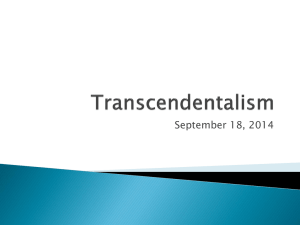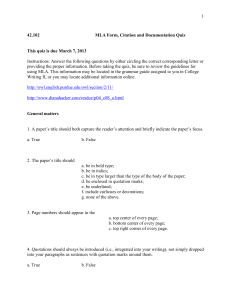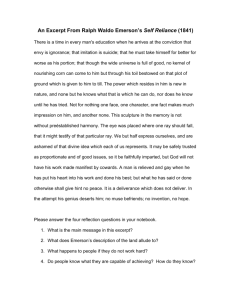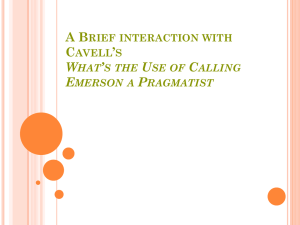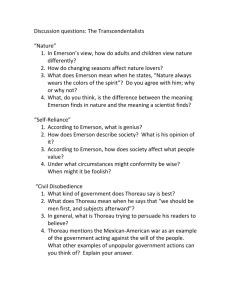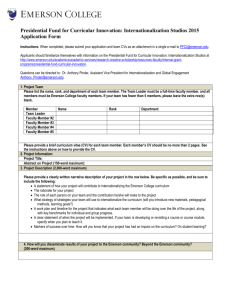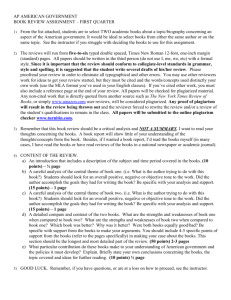MLA FORM, CITATION, AND DOCUMENTATION QUIZ (Part 1—16
advertisement
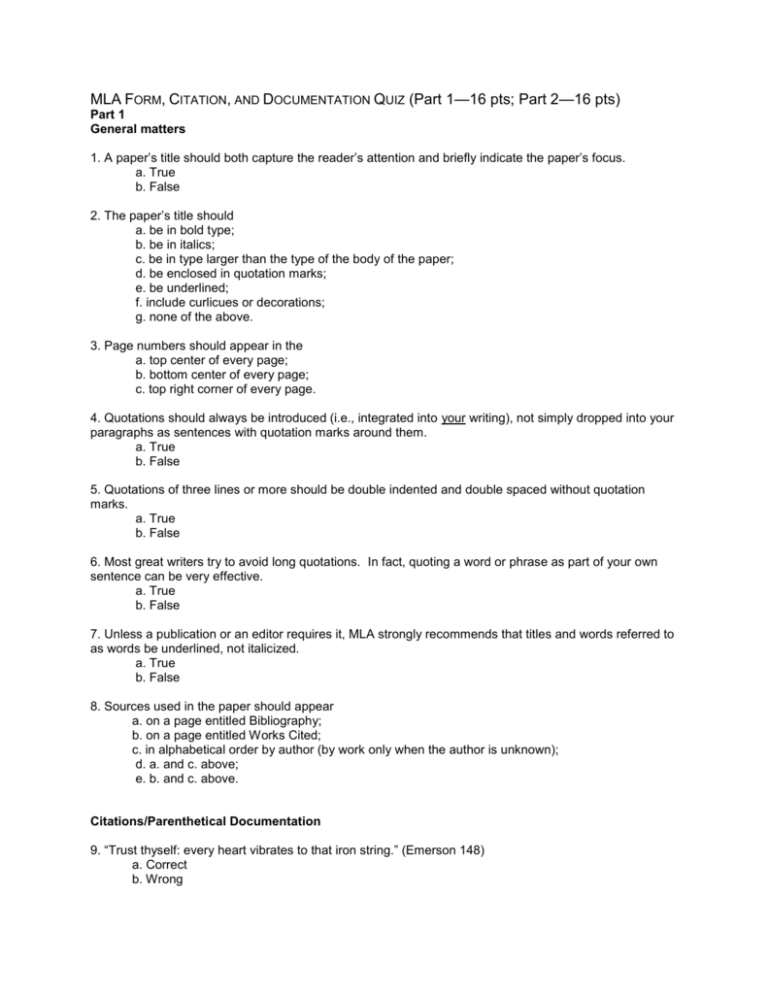
MLA FORM, CITATION, AND DOCUMENTATION QUIZ (Part 1—16 pts; Part 2—16 pts) Part 1 General matters 1. A paper’s title should both capture the reader’s attention and briefly indicate the paper’s focus. a. True b. False 2. The paper’s title should a. be in bold type; b. be in italics; c. be in type larger than the type of the body of the paper; d. be enclosed in quotation marks; e. be underlined; f. include curlicues or decorations; g. none of the above. 3. Page numbers should appear in the a. top center of every page; b. bottom center of every page; c. top right corner of every page. 4. Quotations should always be introduced (i.e., integrated into your writing), not simply dropped into your paragraphs as sentences with quotation marks around them. a. True b. False 5. Quotations of three lines or more should be double indented and double spaced without quotation marks. a. True b. False 6. Most great writers try to avoid long quotations. In fact, quoting a word or phrase as part of your own sentence can be very effective. a. True b. False 7. Unless a publication or an editor requires it, MLA strongly recommends that titles and words referred to as words be underlined, not italicized. a. True b. False 8. Sources used in the paper should appear a. on a page entitled Bibliography; b. on a page entitled Works Cited; c. in alphabetical order by author (by work only when the author is unknown); d. a. and c. above; e. b. and c. above. Citations/Parenthetical Documentation 9. “Trust thyself: every heart vibrates to that iron string.” (Emerson 148) a. Correct b. Wrong 10. “Trust thyself: every heart vibrates to that iron string.” (Emerson, 148) a. Correct b. Wrong 11. “Trust thyself: every heart vibrates to that iron string” (Emerson, 148). a. Correct b. Wrong 12. “Trust thyself: every heart vibrates to that iron string” (Emerson 148). a. Correct b. Wrong 13. “Trust thyself: every heart vibrates to that iron string” (Emerson 148, emphasis mine). a. Correct b. Wrong 14. Welter argues that the “True Woman” of the nineteenth-century was characterized by “piety, purity, submissiveness, and domesticity” (Welter 152). a. Correct b. Wrong 15. Welter argues that the “True Woman” of the nineteenth-century was characterized by “piety, purity, submissiveness, and domesticity” (152). a. Correct b. Wrong 16. In “Notes on the Next War: A Serious Topical Letter,” Hemingway states, They wrote in the old days that it is sweet and fitting to die for one’s country. But in modern war there is nothing sweet nor fitting in your dying. You will die like a dog for no good reason (209). a. Correct b. Wrong Plagiarism Quiz (10 points) 1. The media regularly reports on prominent individuals who have plagiarized academic writing, speeches, or books—for example, Martin Luther King, Stephen E. Ambrose, and Doris Kearns Goodman—but whose careers are not destroyed. Thus, it is clear that our society is conflicted on the subject of plagiarism. a. True b. False 2. Plagiarism in ENC 1101 or 1102 at USF refers to when a student turns in work purported to be her or his own but uses the ideas, words, or even development/organization of someone else without proper acknowledgment; plagiarism can lead to failure on a paper, failure in a course, and even dismissal from the University. a. True b. False 3. Material on the Internet/Web falls into the public domain and, thus, can be used freely without acknowledgment/documentation. a. True b. False 4. When I paraphrase an idea or argument or use a short quotation from a lecture or television program, no acknowledgment/documentation is required. a. True b. False 5. The important issue with plagiarism is that the material be original; thus, I can use a paper or brief passages written by my parents, my roommate, or even from an online site without being guilty of plagiarism. a. True b. False 6. The real issue with plagiarism is how many words I change in a passage another has written; for example, if I change the tenses or drop, say, one fourth of the words or move the order of the words around, I am not plagiarizing. a. True b. False 7. Without appropriate acknowledgment/documentation, all of the following are examples of plagiarism: paraphrasing without documentation; copying charts or graphs or images even with changes made (because the “idea”/ structure/organization/composition remains); and submitting someone else’s work or copying someone’s homework or lab report. a. True b. False ******** Mary is writing a paper on individualism. She has carefully copied three passages from Emerson to use in her paper, which are taken from this source: Emerson, Ralph Waldo. “Self-Reliance.” Selections from Ralph Waldo Emerson. Ed. Stephen E. Whicher. New York: Houghton Mifflin, 1957. 147-68. “There is a time in every man’s education when he arrives at the conviction that envy is ignorance; that imitation is suicide; that he must take himself for better for worse as his portion . . . ” (147-48). “Trust thyself: every heart vibrates to that iron string. Accept the place the divine providence has found for you, the society of your contemporaries, the connection of events. Great men have always done so . . .” (148). Society everywhere is in conspiracy against the manhood of every one of its members. Society is a joint-stock company, in which the members agree, for the better securing of his bread to each shareholder, to surrender the liberty and culture of the eater. The virtue in most request is conformity. Self-reliance is its aversion. It loves not realities and creators, but names and customs. Whoso would be a man, must be a nonconformist. (149) In the first draft of her paper Mary wrote the following passages. Has she plagiarized? It’s very important for each person to examine and understand who he or she is and to think and act as that individual. When people imitate others rather than discover and express themselves, they are really—in an important way—committing suicide because they are negating their own thoughts, their own decisions and consequent actions. 8. Has Mary plagiarized? a. Yes b. No Struggling to be oneself in the world today is not an easy task. The virtue in most request is conformity (Emerson 149). Many people seem to prefer to be surrounded by friends and acquaintances with very similar or even identical views. They feel threatened even by discussions that involve ideas or beliefs different from their own. 9. Has Mary plagiarized? a. Yes b. No In fact, it would be accurate to say that society prefers “names and customs,” not “realities and creators,” in fact, that “[s]elf-reliance is [society’s] aversion” (Emerson 149). 10. Has Mary plagiarized? a. Yes b. No
